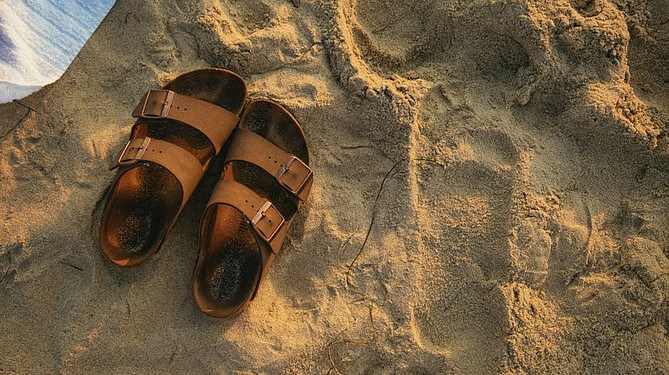Lucky enough, most of these foot problems related to diabetes and diabetes neuropathy can be prevented or managed by wearing good and protective diabetic footwear. Diabetic footwear doesn’t have to be only socks and closed shoes, you can also rock comfortable and good supportive sandals especially during the summer. This article lists the best sandals for diabetes and diabetic neuropathy.
About 60-70% of diabetic patients usually develop neuropathy which makes one to loss of sensation at the body’s extremities. This means when you have any cuts, bruises, blisters or sore on your leg or feet, you may not feel the pain, and you may not notice when your leg is too cold or too hot. All of these can result in serious infections and complications.
When a diabetic patient had even a minor leg injury, the poor blood circulation at the lower extremity can be prolonged and slow down the healing process which may increase the risk of the injuries developing into ulcers and other foot problems like;
athlete’s foot,
blisters,
dry skin,
fungal infection of nails,
Ingrown toenail calluses/corns,
plantar warts and
in more severe case gangrene, which may result in amputation.
Lucky enough, most of these foot problems related to diabetes and diabetes neuropathy can be prevented or managed by wearing suitable and protective diabetic footwear.
Diabetic footwear doesn’t have to be only socks and closed shoes, you can also rock comfortable and good supportive sandals, especially during the summer.
Tip: Nano socks are one of the best socks for people with diabetics neuropathy.
Sandals aside from being fashionable, are breathable and can control moisture which will reduce the risk of fungal infection.
Footwear for Diabetics
As a diabetic, one of the ways to protect and keep your feet safe both indoors and outdoors is by always putting on footwear. It is equally important that you choose the right diabetic footwear.
Diabetic footwear are shoes, socks or inserts specially designed to help to protect your feet and reduce be the risk of injuries, neuropathy, numbness, blisters, ulcers foot pain or prevent the foot problems from getting worse.
Diabetic footwear offers additional support to your foot by reducing the level of pressure, friction and stress on the feet, absorbs shock, and provide a great level of cushioning than standard footwear. This kind of exceptional support and protection reduce the amount of pressure and stress placed on your feet, and the level of wear and rubbing on the skin.
But, really what mean by a sandal?
What are Sandals?
Sandals are light outdoor footwear that leaves the upper part of the foot, especially the front of the feet open. The upper part usually features either straps that are interlaced or simply cross over the instep and sometimes around the ankle to hold the sole of the sandals to the feet.
The soles can be made of rubber, wood, rope, corks and leather and the upper part can also be made by of different such as polyester, suede, fabrics, leather etc.
Although they are not a comfortable as slippers, sandals are perfect for warm weather. They help to keep the feet cool by allowing the feet to breathe and air to circulation freely at the feet. They do not trap any moisture or heat, they allow the feet to get some sun and are more fanciful than slippers.
Tip: Here’s our Accurelief Foot Circulator Review.
Saying so, don’t get confused between sandals and flip-flops.
Sandals vs Flip Flops for Diabetics
Sandals and flip-flops are footwear for summertime both are open toes shoes that give your toes an opportunity to cool off. Although Flip flop is a type of sandal also known as thong sandals or thongs, that doesn’t mean all sandals are flip-flops. There is a distinct difference between the two.
The following are the differences between a sandal and a flip-flop.
Usually, sandals are well-built with strong materials. Their soles consist mostly of thick materials like rubber, leather, wood, cork or rope. They are durable and can be worn to almost everywhere closed-toed shoes can be worn to, and they take up more space than flip-flops.
While Flip flops are easy-to-wear shoes, made of fewer materials so they are lightweight and portable and the materials commonly used are foam, hemp, rubber and plastics. Sometimes fabrics and yarn can be used as part of the design.
Flip flops are usually flat-soled while sandals are either flat or with heels.
Sandals offer better foot support than flip-flops. They are designed to have distinguishable ankle support, even those designed with straps that looks like flip-flops. Flip flops do not have ankle support but only a Y-shaped strap that goes between the big toe and the second toe or designed to have a large, supportive strap worn across the instep.
Sandals are more ‘classy’ and professional-looking and can be worn for a dressy or formal event. Flip flops are simple and better for casual but not a part of any formal wears.
What are the Types of Sandals?
Sandals can be classified into different types depending on the type of materials used for the sandals, the heel and their design.
Types of sandals based on materials used include;
- leather sandals made with leather materials,
- rubber sandals made with rubber,
- rope sandals are made with ropes,
- wooden sandals are sandals which their soles are made with wood.
There are also sandals that are made with plastics, fabrics, lace, straw, ribbons etc.
We also have types of sandals based on their types of heels. There are
- flat heel sandals,
- low heel sandals,
- high heel sandals,
- block heel and
- wedge sandals.
Base on designs, we have –
- flip-flop,
- slides,
- gladiator sandals,
- sling-backs,
- espadrilles,
- sport sandals,
- wedge sandals etc.
Should a Diabetic Wear Sandals?
There is no right or wrong answer to whether a diabetic should wear sandals or not. According to medicine.net, choosing what type of shoe depends on what you find comfortable and what meets your need. There is no medical answer to this question: the best answer I can provide is to use footwear that works for you with diabetes-friendly characteristics. End of the day, you to wear them regularly you should like them and feel good standing in them.
The Best way to work out what is the best sandal for you is to understand diabetic sandals better.
What is a Diabetic Sandal?
Diabetic sandals are supportive sandals that offer comfort and therapeutic benefits, plus the style and versatility that is lacking in most diabetic slippers and athletic shoes.
They are designed to improve breathability, aeration and yet protect the feet from sand, pebbles or any object that can injure the sole of the feet. Features a seamless, smooth and soft interior to protect the feet from irritation that may result to blisters; an anatomically contoured insole for arch support and comfort with a hard grip outsole.
Walking Barefoot vs. Wearing Sandals for Diabetics
Walking barefoot and wearing sandals allows the feet to breathe and for air to circulate the feet and keeps the feet dry, which helps to prevent fungal and bacterial growth.
But if you are diabetic or suffer from neuropathy, it is not advisable for you to walk bare feet because you are more likely to sustain injuries on your feet if they are not protected. If you walk barefoot even when you are indoors, you are likely to step on nails, sticks, pins, pebbles or even a piece of glass and you may also bump your feet on an object.
You can sustain serious burns by walking barefoot on hot soil, pavement or from seashells, glass shred or pebbles at the beach. And all this can result to serious injuries, and if you suffer from neuropathy, you may not notice because you did not feel any pain, but the wounds are there, and your body healing process is now slow. Then, the wound may get infected and in a severe case may result in gangrene and even amputation.
Weaning a sandal will allow for breathability and at the same time protect your feet from stepping on harmful objects. Some of the sandals are designed with bumper toes to protect your toes in case if you bump your toes on the wall, door or any object.
Characteristics of a Good Sandal for Diabetics
A good diabetic sandal should have the following features
- Wide and deep Toe Box
This will give the toe extra room and provide a pressure-free environment, especially, if you have any foot deformities or imbalance due to bunions and hammertoes, which require less pressure.
- Breathability
Diabetic patients, especially those who have foot sores or numbness, need to look for designs of sandals that provide maximum breathability, allows air to circulate on the feet and have moisture-wicking properties. This is because moisture and heat buildup can result in infections.
- Antimicrobial and anti-odor properties
Some sandals come with antimicrobial-treated foot beds which are excellent for diabetic feet.
- Hard Outsole
A hard and protective rubber-based outsole helps to protect your feet against sharp objects.
- Cushioning
A well-cushioned insole and midsole provides a soft and comfortable environment for the foot and helps to absorb shock.
- Adjustable Closures
The feet of diabetic patients have more tendency to be swollen. It is advisable to opt for sandals with adjustable closure if you are diabetic, so that you can adjust the sandal to fit and accommodate your swollen and sensitive feet.
- Seamless with soft interior lining
A seamless, smooth and soft interior to prevent injuries caused by friction and abrasion.
- Low Heels and solid heel
This is for extra and support and stability.
- Rocker soles
This will help to reduce pressure in the areas of the foot like the ball and heel that are most susceptible to pain.
- Removable insoles
This gives you the option of using insert orthotics.
- Stretchable and non-binding uppers
This is to eliminate pressure points, especially for those with a foot deformity and a stretchable upper conforms to the shape of the diabetic foot. Such uppers help to relieve pressure point and provide more protection.
- Orthotic insole
Anatomically contoured insoles conform to the shape of the foot, offers better arch support, and reduce pressure on the sole of the foot.
- Available in multiple widths
Diabetic shoes should be available in different widths – Medium, Wide and Extra Wide for a better fit and protection.
What are the Best Sandals for diabetics?
Here are our best picks.
1. Propet Breeze Sandal For Women

Description and features
Propet Breeze Walker Sandals for women is a comfortable, orthopedic sandal ideal for individuals with diabetes.
With a roomy fit, the sizes of this sandal vary from narrow to extra and extra-wide, so you will definitely get the size that will fit your feet better. It offers different color options and features.
- 100% full-grain leather upper.
- Air-cell Polyurethane sole that is durable and comfortable. This sole measures about 0.5 inches and provides cushion and traction.
- 3 adjustable straps for a custom fit – 2 Velcro straps and 1 buckle strap
- An inbuilt, contoured and cushioned leather-wrapped foot bed for arch support.
Pros
- Dries up quickly
- Fit to size
- Available in different colors
Cons
- The insole is not removable
- The heel strap is not adjustable
2. Orthofeet Alpine – For Men
Description and features
A super comfortable, pain-free and stylish orthopedic sandals with a 60 days money-back guarantee. Designed to help ease stress-induced joint pain and improve stability.
This therapeutic sandal is ideal for people suffering from plantar fasciitis, sensitive feet, arthritis, foot pain, heel pain and neuropathy.
It is available in Medium, Wide and Extra Wide widths, there is something for everyone!
It features
- Soft, adjustable and non-binding leather uppers with smooth inner lining.
- Multiple foam padding that is soft and very comfortable to protect sensitive feet, relieve heel and heel pain caused by flat feet, arthritis and overpronation.
- A hook and loop Velcro strap at the back of the heel.
- Lightweight stride sole with extra depth design that provides enough space for custom made orthotics.
- A removable anatomical contoured arch support insole.
- A wide and comfortable toe box to accommodate swollen feet, prevent and eases pressure on hammertoes, bunions.
Pros
- A lightweight sole
- Extra-depth for custom made orthotics
- 60-days money-back guarantee
Cons
- This sandal is expensive
3. Birkenstock Unisex Arizona Essential Eva Sandals – Unisex

Description and features
For happy feet, get this Birkenstock sandal for any foot type, deformity or condition. This sandal is very comfortable with a supportive design. Available in different colors ranging from light colors to dark colors.
It features
- The cork material also serves as an insulator against the heat and cold and create a good foot climate.
- A soft full-grain leather or suede adjustable uppers to accommodate any foot type and shape.
- Buckle closure for adjustability.
- A durable rubber-based outsole with an excellent grip and traction.
- A well-cushioned, anatomically contoured cork foot bed that supports and relieves pressure on the feet.
- There is also an EVA cushioning in the midsole for even and better shock absorbance.
- The foot bed is lined with suede that absorbs and wick away moisture.
Pros
- It can be worn by anyone with diabetes, both male and female.
- The soft contoured foot bed promotes foot alignment and weight distribution.
Cons
- It is pricey.
4. Timberland Altamond – For Men

Description and features
Looking for a comfortable and supportive outdoor casual sandal that will make you look smart yet relaxed, then this Timberland sandal has you covered.
This sandal is breathable with Smart Comfort Technology for all-day comfort and support. Available in different colors.
It features
- Uppers made of 100% premium leather
- Adjustable hook-and-loop close for a customized fit
- Thermo-regulating lining to help keep the feet warm when the climate is cold or hot when the climate is warm.
- A supportive polyurethane midsole.
- A lightweight EVA foot bed for shock absorption and removable multi-density orthotic for support and all-day comfort.
- Nylon shank for stability and shock dispersion. This shank is airport-friendly, it won’t set off security detectors.
- A durable non-marking rubber outsole with excellent grip and traction.
Pros
- Comfortable and well-built.
Cons
- Expensive, not true to size, the sizing a bit bigger.
5. Clarks Arla Shaylie – For Women

Description and features
A super comfortable formal sandal, pair these Cloud steppers with shorts, denim or any casual wear, and you can be on your way! This sandal is lightweight, flexible and adjustable to fit any feet type and shape.
It features
- A Soft Sock Technology cushion insole for enhanced shock absorbency and more comfort.
- A durable and high traction rubber-based outsole with a heel height of 1.57 inches.
- The stretch fabric upper with a hook and loop ankle strap for adjustability.
Pros
- Versatile and comfortable
- Available in many colors
Cons
- The upper materials are not stretchable.
6. Keen Newport H2 – For Women

Description and features
This closed fisherman style design sandal is a comfortable and adjustable sandal that offers excellent toe protection and feet support for diabetic feet.
It features
- A polyester webbing upper that is washable and water-resistant with a quick to dry lining and Aegis Microbe Shield, an Anti-odor Probiotic Technology.
- A non-marking rubber outsole with razor sipped for excellent grip.
- A rubber toe bumper to prevent injuries.
- Adjustable Lace-lock bungee system.
- Non-removable anatomically contoured EVA foot bed with arch support for more comfort.
- EVA midsole for additional cushioning
- The sole is contoured for arch support and provides a well-cushioned surface.
- There is TPU stability in protection shank and a durable rubber-based outsole.
- The uppers are flexible and adjustable and come with a closed ‘fisherman style’ design for added protection for your feet.
Pros
- It is machine washable
- Soft but sturdy sole
- 12-month warranty
- Lightweight
Cons
- Non-removable insole.
Conclusion
Being diabetic doesn’t’ mean you cannot have fun and it doesn’t mean you have to wear boring or bulky shoes or remain stuck to your sock and athletic sneaker.
A lot of, comfortable and supportive sandals are available that can offer plenty of protection to your feet plus the style and versatility lacking in an athletic shoe and some closed-toe shoes. These sandals will also allow your feet to breath while you enjoy your summer holiday.
Tip: Here are the best foot massagers for diabetics.









